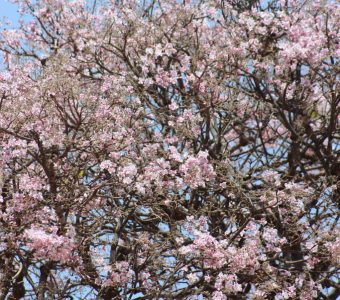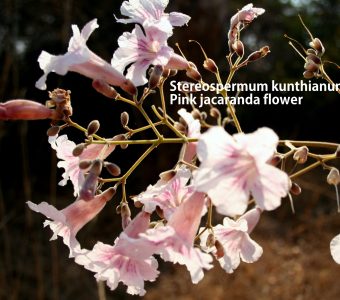

Botanical Name: Stereospermum kunthianum
Common Name: Pink Jacaranda, Kayubule, Mupafu, Mlakanjovu, Mtelelanjobvu, Kavunguti, Mutese .
Plant Family: Bignoniaceae (Bignonia Family)
Growth Form, Habitat and Distribution: A small to medium-sized deciduous tree, normally with a single trunk and untidily spreading branches giving an open crown. Widespread as an occasional tree or group in lower rainfall areas at low and medium altitudes, in Munga and Lake Basin Chipya woodland often in escarpment communities and on termite mounds. except in south-western Zambia.
Size: Height up to 13m, spread 3 to 10m.
Bark: Distinctive feature, smooth and grey, with flakes peeling off in patches.
Leaves: Deciduous, compound in opposite pairs, imparipinnate, opposite with 2 to 4 pairs of stiff, green oblong to eliptic leaflets (5 to 13cm) with the underside with prominent veins and hairy. Petiole 3 to 9cm long, petiolules about 1cm.
Flowers: Dioecious. Large, showy, pink bell-shaped (1.5cm) in drooping sprays, August to October.
Fruit: Long, smooth, slender pods (24 to 50cm), reddish-brown ripening October to December splitting to release numerous winged seeds; the seed pod remaining on the tree for months.
Uses: There are a number of recorded medicinal uses for the bark, roots, leaves and pods. A spectacular garden specimen tree when flowering but unremarkable otherwise.
